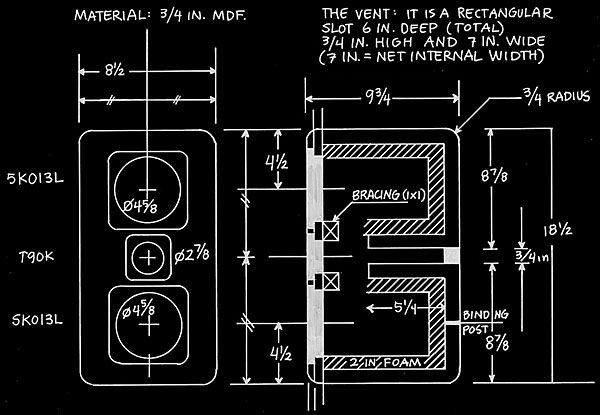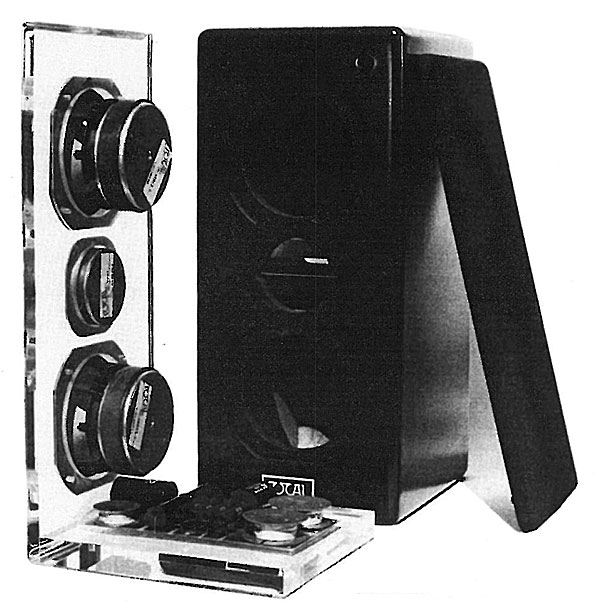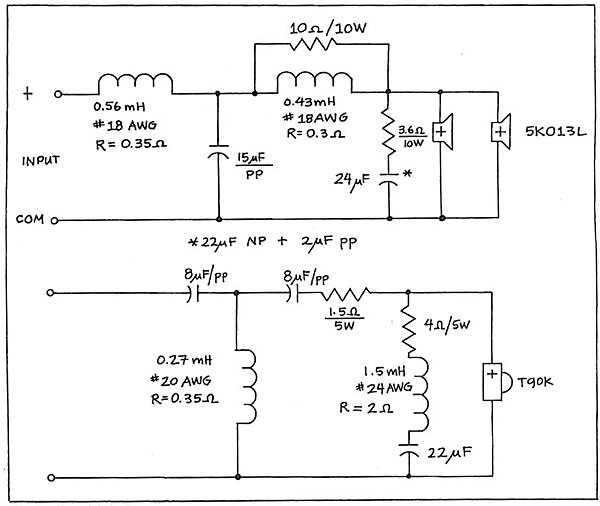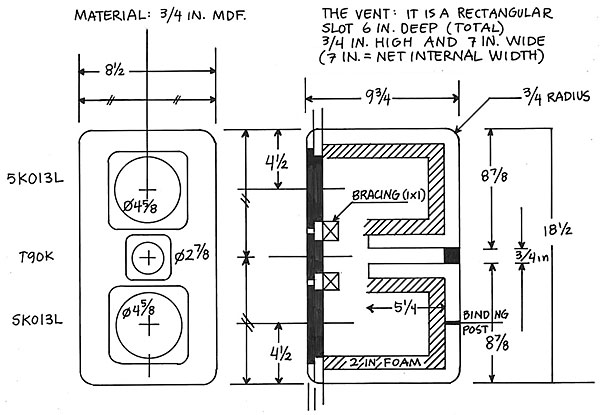| Columns Retired Columns & Blogs |
Focal Aria 5 loudspeaker kit

You don't have to be a seasoned speaker builder to recognize the Focal name. For years they've offered the home constructor a full assortment of quality drivers and kits. The kits were designed in-house—mostly by Focal in France—and, according to Focal, they represent fully engineered and tested systems. The Aria kits (the 5 and the 7), depart from Focal's past policy, in that the project was a collaborative design effort between Dr. Joe D'Appolito and Focal America. Focal's main contribution was in the area of cabinet development, while D'Appolito was responsible for the system integration and crossover design.
D'Appolito is a contributing editor of Speaker Builder magazine, but is best known in the business for a driver configuration he originated and which is appropriately named after him. The basic D'Appolito configuration consists of an array of a single tweeter flanked by two woofers, one above and one below and driven in parallel from a single low-pass network. Both the high- and low-pass crossover networks are normally third-order types. D'Appolito has shown that the acoustic radiation pattern from such a system is quite uniform, both laterally and vertically, within a reasonably broad listening window. The symmetry of the vertical array is, of course, the main reason for the stability of the polar response pattern. This is the essence of the D'Appolito configuration as embodied by the Aria 5. The design objectives were for a horizontal frequency response uniform within ±30° of the listening axis and a smooth falloff at larger angles to reduce undesirable early reflections from nearby walls. The vertical response was to be uniform within ±15° of the listening axis to eliminate "venetian blind" effects. Again, a smooth falloff is desirable at larger angles to minimize ceiling and floor reflections. In general, many commercial speakers have poor vertical polar responses. You can usually find a single axis at which the response is pretty smooth. But as you move up or down—even within a narrow angle—the response deteriorates because of driver beaming or acoustic interference between the drivers.

I firmly believe that accurate and stable imaging requires a loudspeaker to offer uniform frequency response within a listening window that encompasses the head and shoulders at the listening seat. The ear/brain integrates acoustic energy reflected from the head and shoulders. Thus, it is not a single point in space that matters so much as the smoothness of the response in this region. D'Appolito is to be applauded for explicitly incorporating these design goals into the Aria 5 system concept.
The drivers chosen by D'Appolito were naturally restricted to those in the Focal line; the speaker, after all, should highlight Focal's driver technology. The 5K013-L woofer is a 5" midrange-woofer with a so-called K2 sandwich cone: Kevlar/Resin/Kevlar. The cone is slightly flared in an exponential fashion which, together with a phase plug, helps to extend the on-axis frequency response to almost 10kHz. But there's no way of cheating Mother Nature—the woofer starts to beam around 2kHz, the frequency where its size becomes of the order of the wavelength of the emitted sound. This is a moderately robust woofer with a 1" copper voice-coil on a Nomex former. The peak-to-peak maximum linear excursion is a decent 5.5mm. The power handling is not specified, but I would guess it to be around 50W program. The tweeter chosen as "the perfect complement" for the woofers was the T90K, which features a concave Kevlar dome. This dome is claimed to produce smooth, extended high-frequency response with excellent polar dispersion and power handling.
The crossover was designed using computer-aided optimization techniques which allow the designer to take into account the actual impedance variations and acoustic responses of the individual drivers. The target response was a true fourth-order Linkwitz-Riley acoustic network at 2500Hz. The crossover network is shown schematically in fig.1. There are a couple of interesting features worth noting here: first, an upper-bass boost said to provide 5dB of lift at 200Hz, and designed to compensate for the diffraction loss of a free-space speaker; second, the series RLC circuit across the tweeter terminals is designed to damp the tweeter LF resonance, which lies at around 900Hz. This circuit provides a total of 40dB of electrical attenuation at the resonant frequency. Because the crossover point is only 1.5 octaves away from the tweeter's LF resonance, and because of the relatively mild third-order slope of the high-pass filter, the tweeter was considered at some risk of excessive diaphragm motion should even a small amount of electrical power enter the tweeter at this frequency. The RLC circuit effectively eliminates this distortion pathway.

Fig.1 Focal Aria 5 crossover circuit: woofers (top), tweeter (bottom).
The cabinet plans for the Aria 5 are shown in fig.2. The nominal internal volume is 15 liters. Assembled cabinets are available in solid maple and black-satin MDF from Watters Sound Waves in Dallas, TX, Tel: (214) 991-6994. Most of the kit distributors are also likely to offer a ¾" MDF cabinet made by Woodstyle, which is what I got from Madisound. This cabinet is pretty lively. Rapping the enclosure with your knuckles produces an upper-bass ring. Of course, ¾" MDF is far from the ideal enclosure material—I would greatly prefer a sandwich construction—but it's the ticket for a reasonable-quality cabinet at a bargain price. The enclosure side walls are lined with ½" of acoustic foam while its top, bottom, and rear walls are lined with 2" of acoustic foam. Focal's literature points out that "egg-crate" or "waffle" foam, commonly available as mattress pads, may also be used if acoustic-grade foam is not available.

Fig.2 Focal Aria 5 cabinet details.
The Aria uses a Quasi-Butterworth (QB) bass alignment to "obtain maximum bass extension from its midbass drivers." It's true that a QB alignment approximates a maximally flat frequency response and pushes the knee of the curve farther into the deep bass than is possible with other alignments. But there are significant penalties. An octave below the knee of the QB alignment, the bass response is down a whopping 18dB. An alternate alignment called Extended Bass Shelf (EBS), which I like very much, starts rolling off earlier but shelves out and is only down about 5dB where the QB alignment is down a constipated 18dB. In my experience, the EBS alignment, while not measuring as well as the QB, manages to subjectively sound like it has a lot more bass. An even more significant problem is the high box resonance that the QB alignment requires. All vented designs unload the woofer below the box resonance and excessive cone pumping and the attendant host of distortions this generates become a real danger. This is especially a problem during phono playback because of subsonic garbage. For the Aria 5, the box resonance frequency is 57Hz. There's a lot of clean, deep bass that will push the Aria woofers to the wall. Again, the EBS generally produces a box resonance that is almost an octave lower than that of the QB alignment—for the same woofer.
Because this was to be a speaker review and not necessarily a kit report, Madisound sent me a fully assembled and tested pair of Arias. Madisound's Larry Hitch assured me that my pair of Aria 5s were built precisely per Focal's plans and instructions. Had I gotten their semi-kit, with fully assembled crossover boards and cabinets, I would estimate the final assembly as an evening's work suitable even for a first-timer. And here's a nice touch: A set of complimentary solid-brass binding posts may be had from Focal by simply mailing them a copy of your invoice for the components.
The Aria 5 is designed to be stand-mounted at least 3' from the rear wall and any reflecting side walls. More would be better, but less spacing is likely to cause bass emphasis and rough midbass response. The stand should elevate the speakers so that the tweeter axis is near ear level at the listening seat. A slight toe-in toward the listening seat is mentioned as being usually beneficial.
Listening impressions
Situated in the minimonitor location in my listening room—as per Focal's guidelines—the Aria was quick to strut its stuff. Driven by the fabulous Air Tight ATM-2 tube amplifier, its rendition of the soundstage was quite startling in terms of capturing the spaciousness of the original recording venue. I've become quite familiar with the acoustics of the Troy Savings Bank Music Hall through numerous auditions of Dorian Recordings' The English Lute Song (DOR-90109) and Greensleeves (DOR-90126). Here, the Aria clearly revealed hall reverb nuances while image outlines were tightly and cohesively localized within the soundstage. The sensation of 3-D or image palpability was not quite in the class of, say, the Ensemble PA-1, but at a fraction of that Swiss speaker's cost, the Aria's imaging performance was indeed amazing.
- Log in or register to post comments




































